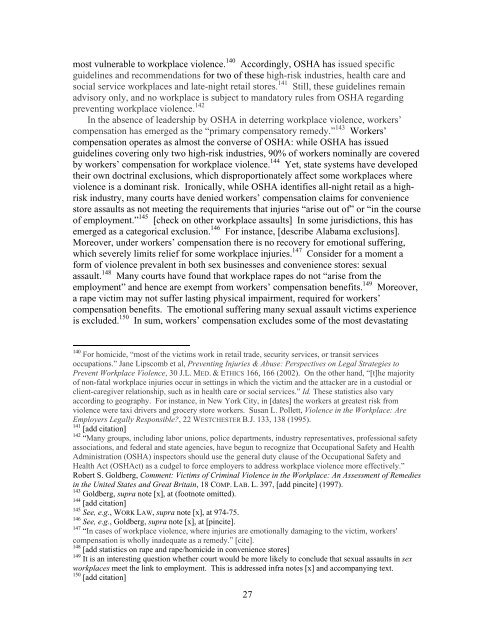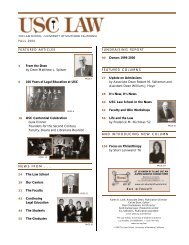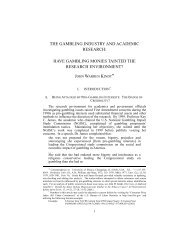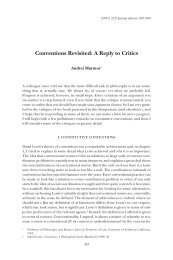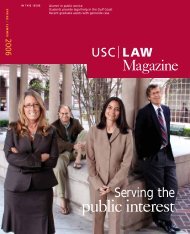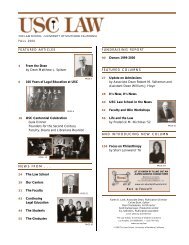1 Regulating Sex Work Adrienne D. Davis VERY ROUGH DRAFT ...
1 Regulating Sex Work Adrienne D. Davis VERY ROUGH DRAFT ...
1 Regulating Sex Work Adrienne D. Davis VERY ROUGH DRAFT ...
Create successful ePaper yourself
Turn your PDF publications into a flip-book with our unique Google optimized e-Paper software.
most vulnerable to workplace violence. 140 Accordingly, OSHA has issued specific<br />
guidelines and recommendations for two of these high-risk industries, health care and<br />
social service workplaces and late-night retail stores. 141 Still, these guidelines remain<br />
advisory only, and no workplace is subject to mandatory rules from OSHA regarding<br />
preventing workplace violence. 142<br />
In the absence of leadership by OSHA in deterring workplace violence, workers’<br />
compensation has emerged as the “primary compensatory remedy.” 143 <strong>Work</strong>ers’<br />
compensation operates as almost the converse of OSHA: while OSHA has issued<br />
guidelines covering only two high-risk industries, 90% of workers nominally are covered<br />
by workers’ compensation for workplace violence. 144 Yet, state systems have developed<br />
their own doctrinal exclusions, which disproportionately affect some workplaces where<br />
violence is a dominant risk. Ironically, while OSHA identifies all-night retail as a highrisk<br />
industry, many courts have denied workers’ compensation claims for convenience<br />
store assaults as not meeting the requirements that injuries “arise out of” or “in the course<br />
of employment.” 145 [check on other workplace assaults] In some jurisdictions, this has<br />
emerged as a categorical exclusion. 146 For instance, [describe Alabama exclusions].<br />
Moreover, under workers’ compensation there is no recovery for emotional suffering,<br />
which severely limits relief for some workplace injuries. 147 Consider for a moment a<br />
form of violence prevalent in both sex businesses and convenience stores: sexual<br />
assault. 148 Many courts have found that workplace rapes do not “arise from the<br />
employment” and hence are exempt from workers’ compensation benefits. 149 Moreover,<br />
a rape victim may not suffer lasting physical impairment, required for workers’<br />
compensation benefits. The emotional suffering many sexual assault victims experience<br />
is excluded. 150 In sum, workers’ compensation excludes some of the most devastating<br />
140<br />
For homicide, “most of the victims work in retail trade, security services, or transit services<br />
occupations.” Jane Lipscomb et al, Preventing Injuries & Abuse: Perspectives on Legal Strategies to<br />
Prevent <strong>Work</strong>place Violence, 30 J.L. MED. & ETHICS 166, 166 (2002). On the other hand, “[t]he majority<br />
of non-fatal workplace injuries occur in settings in which the victim and the attacker are in a custodial or<br />
client-caregiver relationship, such as in health care or social services.” Id. These statistics also vary<br />
according to geography. For instance, in New York City, in [dates] the workers at greatest risk from<br />
violence were taxi drivers and grocery store workers. Susan L. Pollett, Violence in the <strong>Work</strong>place: Are<br />
Employers Legally Responsible?, 22 WESTCHESTER B.J. 133, 138 (1995).<br />
141<br />
[add citation]<br />
142<br />
“Many groups, including labor unions, police departments, industry representatives, professional safety<br />
associations, and federal and state agencies, have begun to recognize that Occupational Safety and Health<br />
Administration (OSHA) inspectors should use the general duty clause of the Occupational Safety and<br />
Health Act (OSHAct) as a cudgel to force employers to address workplace violence more effectively.”<br />
Robert S. Goldberg, Comment: Victims of Criminal Violence in the <strong>Work</strong>place: An Assessment of Remedies<br />
in the United States and Great Britain, 18 COMP. LAB. L. 397, [add pincite] (1997).<br />
143<br />
Goldberg, supra note [x], at (footnote omitted).<br />
144<br />
[add citation]<br />
145<br />
See, e.g., WORK LAW, supra note [x], at 974-75.<br />
146<br />
See, e.g., Goldberg, supra note [x], at [pincite].<br />
147<br />
“In cases of workplace violence, where injuries are emotionally damaging to the victim, workers'<br />
compensation is wholly inadequate as a remedy.” [cite].<br />
148<br />
[add statistics on rape and rape/homicide in convenience stores]<br />
149<br />
It is an interesting question whether court would be more likely to conclude that sexual assaults in sex<br />
workplaces meet the link to employment. This is addressed infra notes [x] and accompanying text.<br />
150<br />
[add citation]<br />
27


